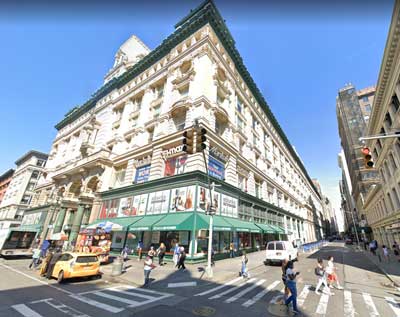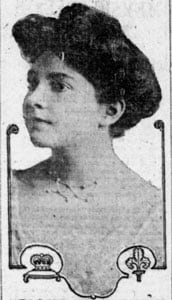Mrs Julia Cavendish was born as Julia Florence Siegel in Chicago, Illinois on 3 November 1886.
She was the only child of Henry Siegel (b. 17 March 1852), a prominent businessman of German birth, and Julia Rosenbaum (b. circa 1862) who had married in Chicago on 8 December 1885. Her mother died when Julia was aged only one month, passing away on the morning of 3 December 1886 aged 24.

Julia’s father Henry
(The Sun, 10 May 1914)
Her father Henry, the son of Jewish farmers, came from modest beginnings and had arrived in the USA from his native Baden, Germany at age 14, later becoming a US citizen. Diminutive in height—his 1884 passport describes him as standing at 4’ 11”—but passionately ambitious, he began his career as a humble store merchandiser in Washington and then worked as a travelling salesman. Later working in the manufacture of womenswear with his brother, after ten years he withdrew his holdings, totalling $75,000, and with a partner organised the firm Siegel & Cooper in Illinois where he opened his first department store in Chicago, Siegel & Cooper Store, with aspirations of becoming “The Department Store King” of the USA. More stores followed: three department stores in New York and the Henry Siegel Co in Boston, among others, earning him the moniker “The Merchant Prince”. With his stores thriving, Siegel branched out to finance, offering his thousands of customers the opportunity to take care of their money matters in the store they shopped in; his self-named bank proved equally as lucrative. Siegel’s fortunes soared and one newspaper declared that he was a “Napoleon of Finance” for several years. He soon had homes at Park Lane in London, a country home at Mamaroneck, New York and a handsome residence at East 82nd Street, New York.


The Manhattan store which sprawled 18th Street, 19th Street and 6th Avenue... the building is still there.
(Brooklyn Citizen, 15 September 1898, Google Streetview)
In April 1898 Henry Siegel remarried; his new bride was Marie Wilde, née Vaughan1 (b. 1863), a young Kentucky-born widow with two daughters, Georgine and Dorothy, who were of similar age to Julia. Marie had come to New York following the death of her husband where she worked by writing fashion articles for newspapers and magazines before she ended up working in one of Siegel’s New York department stores where they met.

Julia’s stepmother, Marie
(New York Tribune, 31 March 1914)
Not much is known about Julia’s early years but what is known that she was privately educated in Europe. She not only moved in social circles in the USA but also in Britain, alongside her two stepsisters Dorothy and Georgine. Georgine was a well-regarded beauty and in 1906 married an Italian nobleman, becoming Countess Carlo Dentice di Frasso.
Julia was also an attractive and popular young woman and on a trip to Britain in the summer of 1906 with her stepmother and stepsister Dorothy, she proved a great social favourite within the fashionable London circles. Whilst there she caught the attention of the wealthy and aristocratic Tyrell William Cavendish of Crakemarsh Hall, Staffordshire and a cousin of the Duke of Devonshire.

Julia, circa 1907
(Chicago Tribune, 15 June 1907)
Cavendish was so taken with Julia that he later crossed the ocean to persuade Mr Siegel to let him have Julia’s hand in marriage. Mr Siegel was protective of his young daughter who was barely 20 years old and who had not yet been formally introduced to society and at first he was averse to her marrying anyone, let alone someone who was not from the USA. Possibly with the persuasion of his wife Marie, who perhaps though it quite the coup to have two titled daughters, Henry finally relented and a marriage date was set upon quite promptly for December 1906.
On 26 December 1906 Julia and Tyrell were married at her parents’ home at East 82nd Street, New York. The bride, who had no attending bridesmaids, “wore a handsome gown of ivory white Irish point lace. Her hat of white velvet was combined with white ostrich plumes…” (El Paso Herald, 4 January 1907). The newlywed couple shortly sailed for England where they would make their home and arrived in Britain on 14 January 1907 aboard Teutonic.
They set up home at Crakemarsh, Uttoxeter, with Julia becoming Lady Cavendish. In June 1907 it was reported that she was among a number of brides presented to their Majesties King Edward VII and Queen Alexandra at Buckingham Palace.
Julia and Tyrell had two sons: Henry Siegel (b. 29 August 1908) and Geoffrey Manners (b. 3 October 1910) and the family appeared on the 1911 census living at Little Onn Hall, Church Eaton, Staffordshire.
Mrs Cavendish boarded the Titanic at Southampton with her husband and her maid Ellen Mary Barber. They travelled as first-class passengers (ticket number 19877, £78 17s) and occupied cabin C-46. They were travelling to visit Julia's father at his country home, Orienta Point, in Mamaroneck, New York.
Mrs Cavendish and Miss Barber were rescued in lifeboat 6 but Mr Cavendish was lost in the sinking, his body later being recovered and forwarded to New York for cremation. She later recalled:
 "I was in the second boat. My husband kissed me and bade me remain in the boat, declaring he was all right. There was no light, but the sky was clear. Bright skies illuminated the scene of the disaster. Just as the lifeboat was lowered I again kissed my husband. He assured me he would rather stay on the boat, thinking he would be safe... As the boat reached the water there were twenty-three women in the boat and two men to guide and row her. Many of us women implored men on the upper deck to come to our succour, but most of them said they could not row. One man there was about to get in the boat, but a sailor, after questioning him threw him aside. A Canadian, who stated that he could row turned to a group of men on the deck who were watching the proceedings and said: "I can row, but if there is room for one more let it be a woman."
"I was in the second boat. My husband kissed me and bade me remain in the boat, declaring he was all right. There was no light, but the sky was clear. Bright skies illuminated the scene of the disaster. Just as the lifeboat was lowered I again kissed my husband. He assured me he would rather stay on the boat, thinking he would be safe... As the boat reached the water there were twenty-three women in the boat and two men to guide and row her. Many of us women implored men on the upper deck to come to our succour, but most of them said they could not row. One man there was about to get in the boat, but a sailor, after questioning him threw him aside. A Canadian, who stated that he could row turned to a group of men on the deck who were watching the proceedings and said: "I can row, but if there is room for one more let it be a woman."
Julia and her maid Ellen returned to England to be reunited with her sons.
The loss of her husband was only the first in a series of woes for Julia Cavendish. Her husband not only left her with two small children to raise but with a lawsuit on her hands.
The suit was for possession of her home, Crakemarsh Hall and the claimant was one Ben Tyrell, an elderly one-legged cab driver from Burton-on-Trent who also claimed a large sum of money, estimated at $1,000,000 received by her late husband’s cousin Harry Cavendish from the sale of Thornton Hall in Buckinghamshire. Mr Tyrell also put forward pretension to the Tyrell baronetcy, showing proof that his ancestors were rightful heirs to the baronetcy and its estate. Mutilated parish registers, the intentional destruction and removal of monuments and tablets to the memory of members of the Tyrell family pointed to the fact that foul play may indeed have been involved in diverting the Tyrell baronetcy away from the rightful heirs and into the hands of a lawyer who was married to the niece of Sir Charles Tyrell, who died without issue. Although it is known that Crakemarsh Hall remained in the possession of Julia, further details about this case remain obscure.
Back in the USA her father’s empire had begun to crumble. Julia’s stepmother, who was popular in social circles in Europe and America, spent eye-watering amounts of money, more money than it soon emerged that the family possessed and in 1910 she and Henry were separated, he continuing to pay her $25,000 a year. In 1914 Siegel enterprises went into bankruptcy and Siegel Bank was found to be insolvent. Bank examiners found gaping shortages in the alleged assets of the bank and Henry Siegel was indicted on charges of obtaining money under false statements and receiving deposits after he knew the bank was not solvent. The collapse of his bank ensured the collapse of his department stores. During investigations, Mr Siegel disappeared and boarded, of all ships, Olympic under an assumed identity in order to reach his daughter Julia. Scotland Yard caught up with him in London and he was arrested and sent back to New York for trial.
Found guilty on several counts, Henry Siegel went to prison for nine months. His wife Marie, who attested that her marriage to him had been uneasy for several years, initiated divorce proceedings in April 1914.
Henry Siegel remarried in 1918 to a younger woman, Henrietta Struble, née Malone (b. 1882 in New Jersey), a young widow with two teenage daughters. They settled in Bergen, New Jersey where in 1920 Siegel was living and described as an exporter in the corn business. He also tried his hand at selling women’s wear before opening a haberdashery in New Jersey but he lived in much more modest circumstances than those to which he had been accustomed until only a few years previously. His third marriage also ended in divorce in the 1920s when wife Henrietta began having an affair with one of the clerks in his haberdashery. When his health declined and he neared death Henry and Henrietta reconciled but he died in obscurity not long after in Lakewood Hospital on 25 August 1930.
Julia Cavendish was never remarried and remained the wealthy dowager of Crakemarsh Hall, Uttoxeter where she lived for the rest of her life. During WWII US troops were billeted at her home. She continued to travel the Atlantic many times over the years but apart from that little else is known about her later life.
Julia Siegel Cavendish died on 16 January 1963 aged 76 and left a personal estate valued at £5266, 8s to both her sons. She was cremated and her ashes are interred in Golders Green Crematorium, London. Crakemarsh Hall came out of Cavendish hands in the late 1960s, was later abandoned altogether during the 1970s following a devastating fire, and was eventually demolished in 1980.
Both her sons were later married and both raised families. Henry died in 1995 and William in 2007.




Comment and discuss
Showing 15 posts of 87 total. View all.
Open Thread Leave a Reply Watch Thread